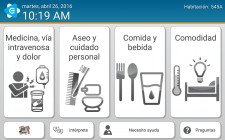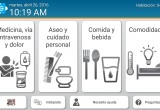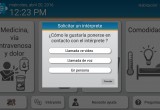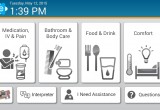Michigan IT Company Designs Tool That Brings Communication Between Patient and Caregivers Into the 21st Century

Ann Arbor, Michigan, July 6, 2016 (Newswire.com) - Research shows that hospitals in the US waste about 12.3 billion dollars annually due to inefficiencies in communication between caregivers and their patients. Of the money wasted, roughly 5 billion dollars is due to latency in nurse communications.1 Furthermore, with well over 80% of hospitals caring for patients with LEP, the health care information technology industry can no longer ignore the needs of patients with limited English proficiency.2
According to nurses who cared for limited English proficiency (LEP) patients in recent focus groups published in Global Qualitative Nursing Research, several barriers to communication with LEP patients were identified – formal tools for communication lacked in quality, these tools were not immediately accessible despite being available and were not user-friendly (e.g., had to leave the patient to retrieve them or go through a series of steps to activate the process). Nurses also reported significant long delays, sometimes 1-2 hours, getting an in-house interpreter, reliance on family to translate, gestures and charades being a significantly ineffective and error-prone form of communication, and the need for a more efficient call light system.
"We had a Chinese family, it was about 8 months ago, the [interpreter] service wasn't sure if the family was accurately telling the patient what their condition really was, outcomes, etcetera . . . So the patient wasn't able to make informed decisions about what they wanted . . ."
Study Participant, R.N.
Nurse participants expressed frustration that “failure to communicate with the patients meant that they were not able to give the right kind of care that they want to provide.” Here are some of the things they had to say:
“It gets really hard when the family is not available . . . The son left and didn’t come back for another day so that becomes difficult with just small things to call the interpreter every single time for something very small.”
“We had a Chinese family, it was about 8 months ago, the [interpreter] service wasn’t sure if the family was accurately telling the patient what their condition really was, outcomes, etcetera . . . So the patient wasn’t able to make informed decisions about what they wanted . . .”
“And a lot of times, they [patients] will just nod and say yes all the time . . . And then you get a family member in who speaks English and you’ll ask the same question. They’ll be like ‘no.’ “
Eloquence Communications, Inc., an IT health care company based in Michigan, has created the Language Access Solution (LAS), a comprehensive solution that empowers health care providers by removing work flow and time-constrained barriers to translation/interpretation services for patients and caregivers. Eloquence LAS empowers health care facilities in the most cost-effective and care-efficient way by providing immediate translatability of all communication needs and keeping this access within reach of the patient at all times.
Eloquence’s Language Access Solution (LAS) addresses this critical problem by providing patients immediate access to a touchscreen tablet device displaying 30 of the most common requests in English or in their native language. From this tablet, a patient’s request is routed to the appropriate caregiver on their mobile device, the nurse or aide acknowledges the request, and a confirmation is sent back to the patient – in their preferred language. Equally as valuable is LAS's feature that allows the patient to speak with a live interpreter simply with the touch of an icon on the device. For hospitals and healthcare facilities, LAS is customizable, intuitive, requires no capital expense, and its WIFI connectivity makes installation a simple plug-and-play solution, avoiding any disruption to patient care. For patients, this system is empowering, reliable, and ensures more equitable, quality care that could prove life-saving.
When the same nurses evaluated the Eloquence LAS, here is what they had to say about it:
“I think it [Eloquence™] would facilitate communication much better.”
“The thing is that it would allow them [patients with LEP] to pretty confidently request specifically what they want; stuff that before that they may have had some difficulty communicating and we understand it now.”
“You could save a lot of time for the patient in getting pain meds or nausea meds, because you would know what they want.”
“Being able to choose what they want, you know their safety factor. They would feel safer because they are able to communicate.”
“I think they [patients with LEP] would feel more satisfied with their care because they can actually explain to us what they need . . . I think they would be happier as patients to be able to express their needs.”
About Eloquence Communications, Inc.
Eloquence Communications, a healthcare IT company founded by physicians, is dedicated to improving the delivery of care through the development of innovative and simple communication solutions. Eloquence brings an unprecedented level of transparency and efficiency to fulfilling patient requests. This shift in clinical practice will increase in transparency the very moment when patients initiate a call request, bypassing the requirement for providers to triage those call requests. Coupled with transparency, both the level of urgency and “intelligent” routing to the most available and appropriate providers (both based on the context of each request) aim to reduce the length of time it takes to fulfill patient call requests. Additionally, by monitoring call request status and generating automatic prompts for providers, Eloquence may also reduce missed care, improve patient safety and improve patient and provider satisfaction.
For more information about Eloquence Communications, Inc. and the Language Access Solution program, contact: Eloquence Communications, (855) 422-3567, sales@eloquencecomm.com
Disclaimer | Research reported in this publication was supported by the National Institute On Minority Health And Health Disparities of the National Institutes of Health under Award Number R42MD006149. The content is solely the responsibility of the authors and does not necessarily represent the official views of the National Institutes of Health.
1. Agarwal R, Sands DZ, Schneider JD. Quantifying the economic impact of communication inefficiencies in U.S. hospitals. Journal of Healthcare Management, 2010; 55(4):265-81; discussion 281-2.
2. Hasnain-Wynia R, Yonek J, Pierce D, et al. Hospital Language Services for Patients with Limited English Proficiency: Results from a National Survey. Chicago, IL: Health Research and Educational Trust, 2006.
3. Montie M, Galinato J, Patak L, Titler M. Perspectives of Nurses on Patients with Limited English Proficiency and their Call Light Use. Global Qualitative Nursing Research, 2016; 3:1-9.
Source: Eloquence Communications, Inc.



